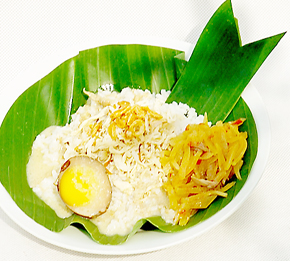1. Wedang Jahe
2. Bajigur
Bajigur is the typical hot drink of Sundanese people of West Java, Indonesia. Its mainingredient is sugar palm, and coconut milk. To add a little pleasure mixed too ginger,salt and vanilla powder.
Beverage are served hot is usually sold with the use carts that include a stove. Bajigurbest drunk at the time of cold and wet weather after the rain. Meals are often servedwith boiled banana bajigur, boiled yams, or boiled peanuts.
3. Cendol
Cendol is a traditional dessert originating from Indonesia. The dessert's basic ingredients consist of coconut milk, a worm-like jelly made from rice flour with green food coloring (usually derived from the pandan leaf), shaved ice and palm sugar. Next to these basic recipe, other ingredients such as red beans, glutinous rice, grass jelly, creamed corn, might also be included.
In Sunda, Indonesia, cendol is a dark green pulpy dish of rice (or sago) flour worms with coconut milk and syrup of areca sugar. It used to be served without ice. In the Javanese language, cendol refers to the green jelly-like part of the beverage, while the combination of cendol, palm sugar and coconut milk is called dawet. The most famous variant of Javanese es dawet is from Banjarnegara, Central Java.
4. Es Teler
Es Teler is iced drinks contain pieces of avocado, young coconut, jackfruit cooked,and coconut milk diluted with sweetened condensed milk and a syrup. Ice can be usedshaved ice or ice cubes.Other variations include Cincau ice jazzed, and fro, and boyfriend china, pieces ofapple, papaya, sapodilla, melons, bread, and jelly, ice jazzed up to be difficult to distinguish from mixed ice.
5. Es Cincau
Cincau is a kind of ice beverages with a main ingredient gel-like agar-agar, known asCincau. Cuts Cincau plus syrup, coconut milk (or milk) and shaved ice so that it becomes a refreshing beverage.Cincau used vary depending on the leaves of plants that are used : Cylea barbata Miers, green Cincau, resulting in a green gel ; Palustris charming Bl. (black Cincau); produce black gel ; or Melasthoma polyanthum (Cincau shrubs).
6. Es Doger
Es Doger, is a kind of ice drinks mixed with the contents of a simpler. Es Dogercontains black sticky rice, avocado, tape, and mixed with ice shavings that have beengiven the coconut milk and slices nagka. After that the top is sprinkled with pandansyrup and condensed milk. Eating es Doger very good in the daytime during hotweather. Ice Doger can be found in cities like Bandung in West Java and Bogor, andthe price per glass is quite cheap about three to five thousand dollars only. Now this esDoger been somewhat rare, and usually the seller only use a small cart.







